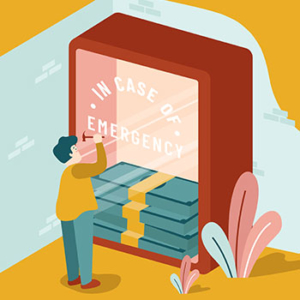 Being a parent in 2022 comes with its own unique set of challenges: baby formula shortage and inflation, to name a few. Speaking of inflation, the Bureau of Labor Statistics just announced June’s Consumer Price Index was up 9.1% over the past 12 months. Cool, cool, cool. So many people are not sure where to start when it comes to finances and how to adapt in this new stage of life. Don’t fret; your friendly neighbor financial planner is here to help!
Being a parent in 2022 comes with its own unique set of challenges: baby formula shortage and inflation, to name a few. Speaking of inflation, the Bureau of Labor Statistics just announced June’s Consumer Price Index was up 9.1% over the past 12 months. Cool, cool, cool. So many people are not sure where to start when it comes to finances and how to adapt in this new stage of life. Don’t fret; your friendly neighbor financial planner is here to help!
In the first part of this blog series for new parents, we talked about some key ideas to protect and maintain your financial picture: study your employer benefits like Dependent Care Flexible Savings Accounts; review current life insurance and disability insurance, and build or update your estate plan. In this month’s series, we will discuss your current household cashflow and building a plan around it!
 Now is the time to take account of your current household spending and update your budget with your new addition(s) to the family.
Now is the time to take account of your current household spending and update your budget with your new addition(s) to the family.
What you anticipated spending six months ago could look very different from what you are experiencing now. A simple way to evaluate your current cashflow is to check your bank account or credit card account online and look at the transactions over the past month or two. You could print them and go over them with a highlighter or export them into an Excel spreadsheet and color code the expenses and income—because what good millennial actually has a printer at home?
Having this awareness of where your money goes every month is key!
When you subtract your total expenses from your income, is there a positive amount left at the end of the month or a negative amount? If you have a positive amount at the end of the month, focus on building your emergency fund, saving for the future, or using those extra funds to pay down debt. If there is a negative amount at the end of the month, look at areas to trim your spending, like eating out or monthly subscriptions. Build out a monthly “budget” so that you are telling your money where to go instead of it telling you where it will go. You may notice your expenses go down as you’re more aware of where your money is being spent.
 Secondly, and this is so important, build your emergency fund.
Secondly, and this is so important, build your emergency fund.
You need to be able to cover you and your family in the event something unexpected happens. How much should you have in your emergency fund? I recommend my clients at least have three to six months of basic expenses in their emergency fund. Calculate the expenses you need to live on for a month and multiply that number by three or six. I usually recommend you have your emergency fund in a savings account. I will tell clients to have an amount automatically transferred from their checking or paycheck to their savings account. Set an amount that is feasible for you, even if it is only $50 a month. You will be so surprised at how quickly you will build up your savings by automating that decision and keeping it out of your spending account.
After you have reviewed your cashflow and built your emergency fund, evaluate your current debts.
Create a plan to eliminate debt or reduce where you can. This will make more room in your cashflow by eliminating those pesky monthly payments. The key pieces of information you need to know are the following: interest rate, remaining balance, minimum payment, remaining term of payment, and initial term of payment. Get this information and list it out if there are multiple. Here are some popular ways you can “attack” your debt:
- The Snowball method- paying the smallest balances off first. Then when your first debt is paid off, you can add those payments to the next debt you are paying. The payments start small and then “snowball.”
- The Avalanche method- Paying off debts with the highest interest rates first. Once you have paid off the highest interest rate debt, you move on to pay the next highest interest rate debt.
The best method to choose is the one you think you will see through to the end. Both have their merits.
Adding a new family member or two can make big changes to your lifestyle. Now’s the time to assess and adapt by being aware of what goes in and what comes out! As a financial advisor, it brings me joy to see when families set financial goals and accomplish them together. New parents, you’ve got this!
August 2022

 Now is the time to take account of your current household spending and update your budget with your new addition(s) to the family.
Now is the time to take account of your current household spending and update your budget with your new addition(s) to the family. Secondly, and this is so important, build your emergency fund.
Secondly, and this is so important, build your emergency fund.


